Fishing Report: Father's Day weekend

Going fishing for gag grouper? Pack your patience.
Out deep, gag grouper fishing has also been stellar lately, says Captain Dylan Hubbard of Hubbard's Marina. If you want to get big gag grouper in the summer, you must go deep, bring the big bait, big tackle and plenty of patience and heart.
MADEIRA BEACH, Fla. - Every Friday morning, Captain Dylan Hubbard of Hubbard's Marina joins Good Day to fill viewers in on his fishing forecast as we head into the weekend.
Here is his fishing report for June 18, 2021.
Inshore
The situation inshore right now can be funky from time to time, but overall, we are still seeing a wide variety of nice fish being caught. The trick is finding clearer, cleaner waters and that area seems to concentrate the fish. From the beaches to the back bay waters, there are still plenty of clean pockets of water holding actively feeding fish. However, the trick is finding them and following them as day-to-day things can move around and get shaken up quickly.
The snook fishing has been more spotty but we are still seeing some really nice fish coming up at night around the passes at bridge lights, dock lights, and around the structures. During the day, there are still plenty of beach snook action around the area. For the most part, from John's Pass south along the beaches, the water has been cleaner and clearer more frequently for the morning and dusk beach snook fishing. Back in the back bay waters, we are seeing many snook around the flats, mangrove shorelines, dock lines, and around the islands.
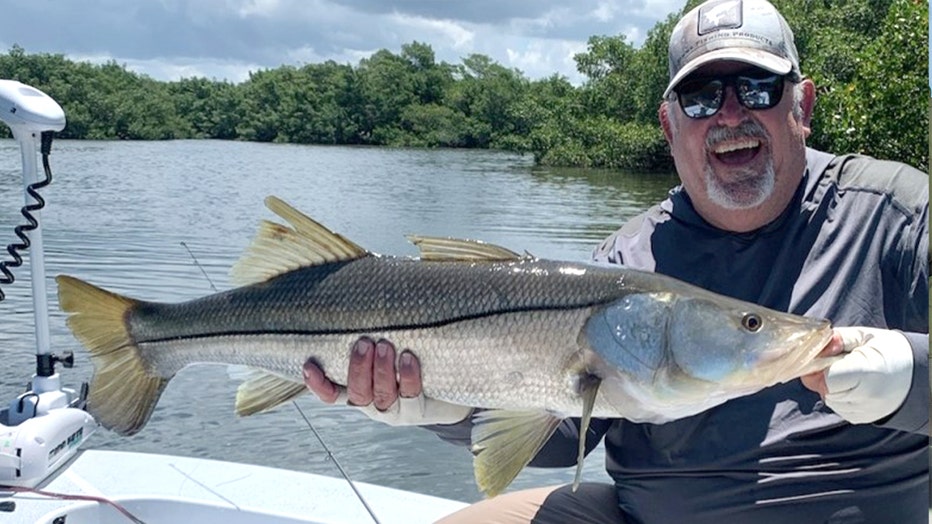
Snook caught inshore (Credit: Hubbard's Marina)
Redfish action is going well around the potholes, cuts, and oyster bars of the local back bay waters. We are seeing pretty steady redfish action around the docks adjacent to the passes as well. Live shrimp on the bottom, smaller pinfish or crabs, and cut dead bait are all great options for redfish when using bait. Soft plastic paddle tails and soft swimbaits are go-to options for artificial lures when targeting these slower moving more bottom-prone gamefish.
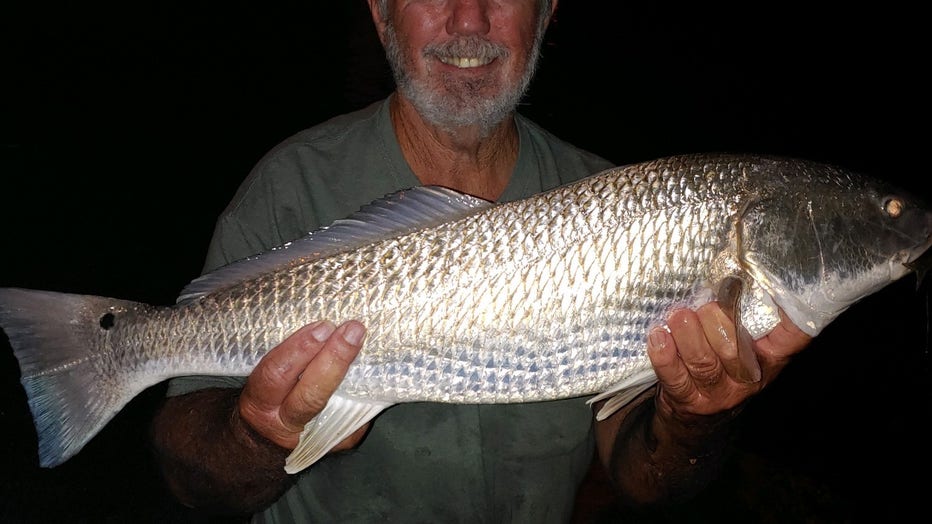
Redfish caught inshore (Credit: Hubbard's Marina)
Trout action has been going well lately this past week. Around the passes, we are seeing them load up dock lights and bridge lights at night. We are seeing active trout along the beaches during the day. Also, we're seeing them around the deeper flats with plentiful grass trout are looking for whitebait and shrimp. However, those soft plastics just above the grass work well too.

Trout caught inshore (Credit: Hubbard's Marina)
Mangrove snapper action is fired up around the local fishing piers, docks, bridges, rock piles, and seawalls of the entire Tampa Bay area. These guys love a piece of shrimp or whitebait and even a whole one on lighter weight and light tackle leaders under 20lbs. Some larger mangroves have been caught in deeper waters around those structures too. Small pinfish are a great way to target the bigger mangrove snapper.
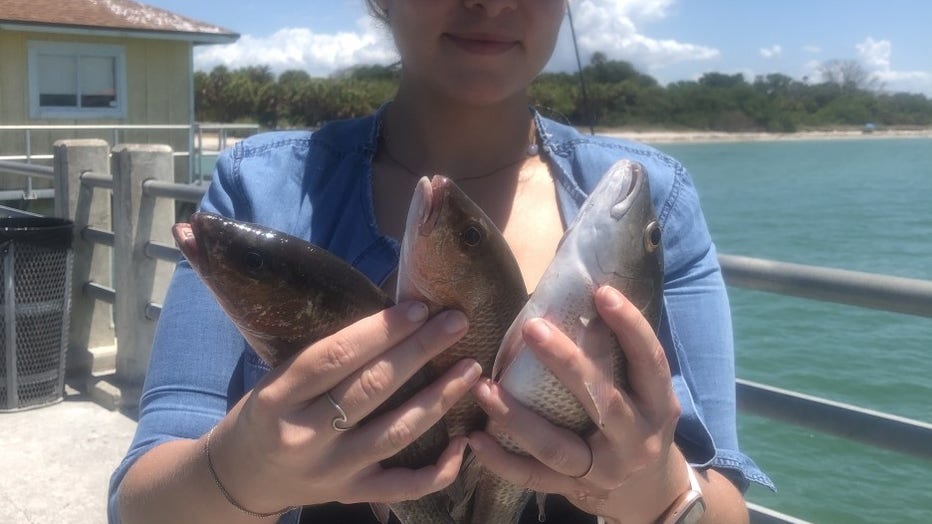
Mangrove snapper caught inshore (Credit: Hubbard's Marina)
Mackerel action is spotty but still present – mostly around the bigger fishing piers in the early part of the day. That is the best place to find mackerel. However, there is still a decent presence of mackerel around those edges of deeper flats where bait is present and water is moving.
Black drum action around the bridges is going well throughout the area too. These guys hang right on the bottom looking for chunks of dead bait like shrimp, crabs or cut threadfin. They have a great fight to them and we're seeing them around local larger dock lines too.
Cobia are in the bay around the piers, flats and following the pods of dolphin, schools of mullet – and even the big fevers of rays! They love a white bucktail with a large darker colored soft plastic eel on the hook to catch their eye and imitate their favorite snack, the eels of the area.
Tarpon action slowed a bit this week with the stronger southwest winds, but we did see plenty of them still around the bridge lights of the area. Plus, a few smaller juvenile tarpon still working local dock lines for the white baits and ladyfish.
Sharks are filling our area from the bonnethead sharks to blacktips and virtually everything in between we are seeing them around local fishing piers, jetties, passes, docks, and anywhere they can find a meal or move to and from the more open waters.
Tripletail are around the bay too, hanging under floating debris, weed lines, and around the markers. Do not forget to check under local buoys too like the pinfish traps along the beaches or flats.
Light tackle and a live shrimp are a great method to sight cast these great eating fish.
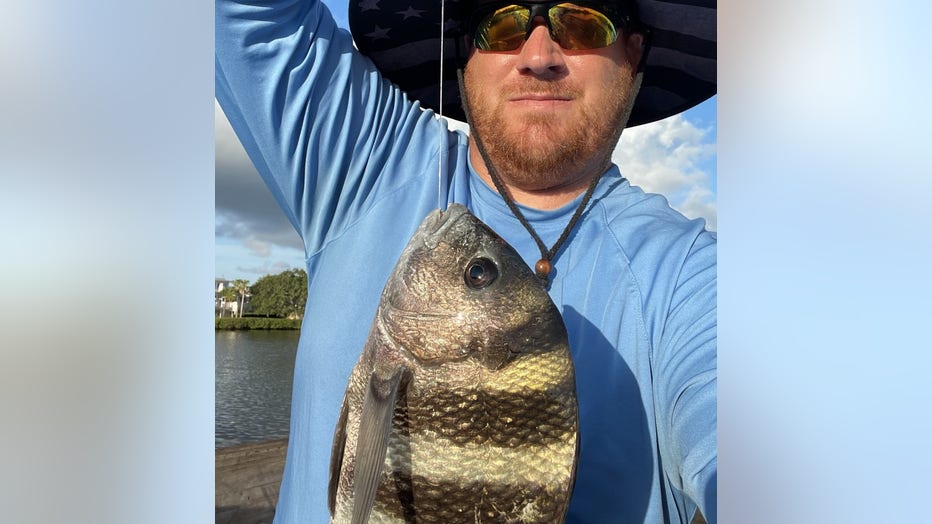
Sheepshead caught inshore (Credit: Hubbard's Marina)
Near shore and offshore
The only upside right now with the environment we are in is that the issues do not extend into offshore deeper waters where the bite is HOT right now. Plus, we only have a truly short red snapper season so taking full advantage of that is important to the area anglers and visitors excited for their shot at a deep-water trophy!
Before venturing offshore, let’s talk about the near shore bite. We are focusing most of our efforts around 60-100 feet of water right now where we are seeing some decent red grouper action. The red grouper are loving the live pinfish, butterflied squirrelfish, octopus, and also squid strips. You don’t need crazy heavy tackle targeting the red grouper near shore around 60lb test and even 40lb, if you’re fishing the flat hard bottom bait shows.
Lane snapper have been crazy thick around this area too. We are seeing plentiful lane snapper be a continuing trend the past few years with the average size continuing to grow. They love just about any bait you can think of from live shrimp to squid and even chunks of threadfin or white baits. However, if you want a chance at the big ones, the larger live shrimp are a great way to target lanes, mangroves, and even some grouper will grab those too!
Mangrove snapper are much spottier near shore, but we are getting a decent bite of mangrove snapper in the near shore areas especially when fishing in those potholes for red grouper, or ledges for gags, or rock piles for a variety of species. They love the structures, and they are looking for chunks of threadfin, sardines, or the live shrimp on lighter tackle.
The mackerel and kingfish action is pretty sparse right now near shore, but we see the occasional mahi mahi school for pelagic action inside 100 feet of water as shallow as 40 feet. The near shore pelagic bite overall right now is pretty slow outside of that rarity.
Offshore, the ball game is completely different, and the bite has been outstanding. We are mostly fishing extremely far offshore since these red snapper are open and there has been so much pressure on the fish. Around 110-120 feet of water, you can start to find the red snapper, but they get beat down pretty fast. Plus, the further you go and the deeper you get, the more concentrated, prolific, and large the red snapper get!
Fishing around 160-240 feet has been a great area for us lately with plentiful big red snapper loving cut dead baits like bonita strips, mackerel, squid strips, whole squid, octopus, and virtually anything that is going to give off plenty of oily stink in the water. However, these fish, when hungry, will eat just about anything you throw at them including jigs, poppers, and even a chicken bone worked this week for one expeditious angler.
Gag grouper fishing has also been stellar for us lately out deep as well. If you want to get big gag grouper in the summer, you must go deep and bring the big bait, big tackle, and plenty of patience and heart. These guys have been loving the octopus, bonita chunks, and bigger live baits that we get once offshore. Getting live pinfish out on the boats has proven tricky over the past week with spotty red tide challenging our live bait team beyond belief. However, every larger gag grouper caught as of late has been on exceptionally large chunks of dead bait like octopus or whole squid.
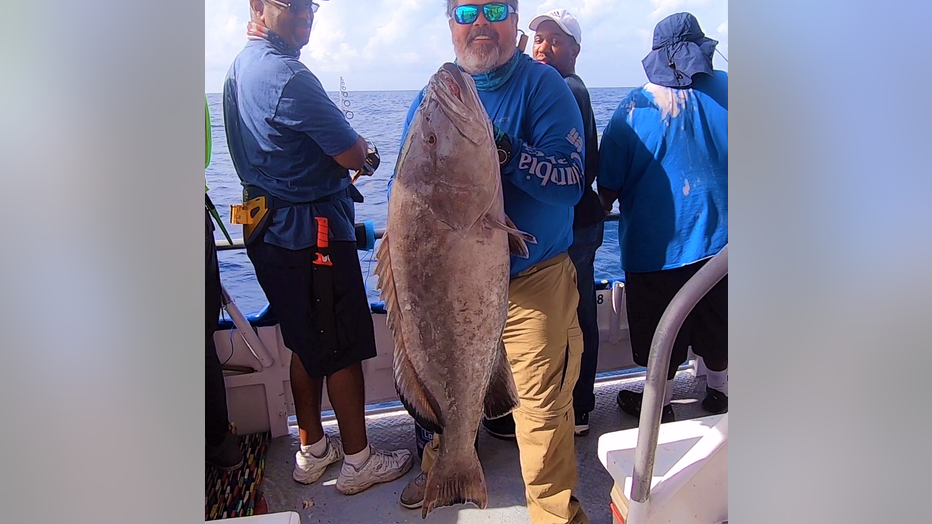
Gag grouper caught offshore (Credit: Hubbard's Marina)
One angler on the mid-week 39-hour caught a 47lb gag grouper using a whole octopus from the shop. After landing the fish and setting it back up, the angler sent the same bait back down to catch a 24-pound gag grouper right behind his nearly 50-pound trophy once-in-a-lifetime fish! That's pretty crazy when a 24-pound big gag is made to look small by your first fish.
Red grouper have been biting well out deep too, but we haven’t been targeting them as much with the red snapper jumping in the boat and the hot gag grouper bite. Those who do are seeing plentiful large red grouper on those deep-water bait shows and potholes.
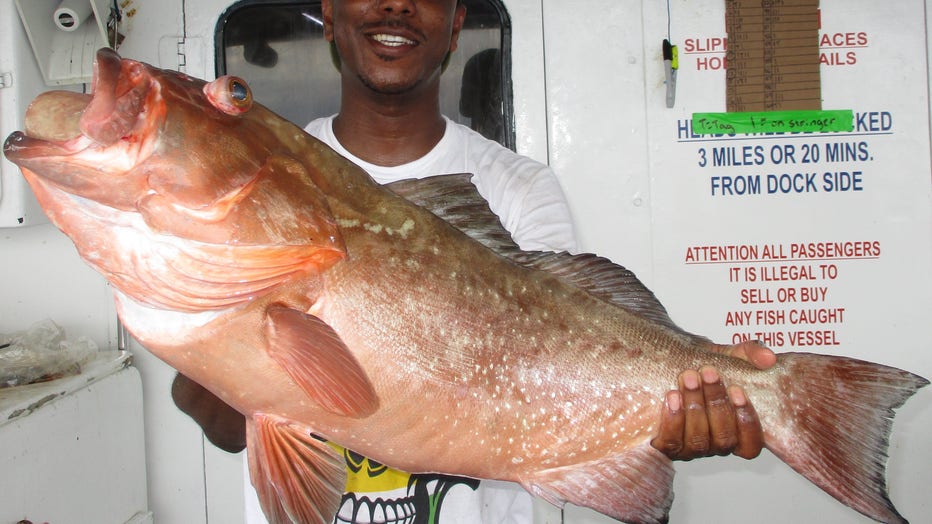
Red grouper caught offshore. (Credit: Hubbard's Marina)
Scamp grouper have been mixed in with both species out deep hanging around those solid structures and loving medium-sized pinfish when we can get them out there, the vertical jigs along the bottom, or even sometimes those chunks of threadfin when targeting mangrove snapper.
Pelagic action out deep has also been spotty. We have seen blackfin tuna, kingfish, wahoo, mahi and even billfish but the bite has been hit-and-miss even when conditions look favorable with flying fish and right temperatures and such.
DON’T BE A FOOL, bring a venting tool & Descending device
Keep in mind the importance of dead discards and discard mortality when engaged in near shore or offshore fishing. How many do you know right now that are all for catching and releasing snook, redfish and trout but will be the first in line to kill a mangrove snapper, gag grouper, or red snapper? But the attitude completely changes when discussing these offshore species?
Plus, the same person inshore that will hold their breath and wet their hands before handling a breeder snook will go offshore and then cull through 20 red snapper before keeping their two red snapper they deem large enough to fill their two-fish bag limits. Meanwhile, the other 18 they released will often end up suffering fatal damage if not properly descended or vented?
Please help us to spread the word on the importance of descending or venting your released fish. Descending devices are most easy to use and quick to pick up on their use. They are most effective for most anglers.
However, an expert and precise angler with proper training and tons of experience can use a venting tool properly with similar outcomes. A venting tool requires you to pierce the fish while most descending devices are much less invasive. While using a venting tool, it is imperative you pierce them in the exact right spot, and you do not go but a quarter-inch or less in the fish. Most venting tools require you to ‘choke up’ on the tool to prevent over-penetration into major organs.
When fishing deep water, especially in the hot summer months, please make sure to treat all fish intended to be released like that breeder snook inshore and minimize the time it takes you to get him from the bottom to the boat using heavier proper tackle, not an ultra-light spinning reel.
Then once onboard, minimize the time out of the water. Then use a proper de-hooking tool and then, for the love of God, use a descending device or venting tool PROPERLY to ensure that fish has a chance to live another day.
Three things will help ensure the survivability of those fish released offshore:
- Making sure they are brought up quickly and do not expend all their energy in the fight.
- Make sure they are unhooked smoothly, easily, and as quickly as possible.
- Finally, make sure they spend the least amount of time at the surface at negative pressures where barotrauma exponentially increases its effect with each passing second.
Also, keep in mind when the water is warm, there is less dissolved oxygen content and the chances of barotrauma increase even more while its effects can be even more deadly.
LINK: Here’s all the information and more on barotrauma and how to mitigate that fatal damage to your future offshore catch
**Note: I recommend the Salt Strong articles at the bottom of the page under ‘webpages.’ I helped them develop those personally.
STATE SURVEY to improve recreational data and access
It is imperative that you have your Gulf Reef Fish survey endorsement on your fishing license.
You should get one if you are a private recreational angler or diver fishing from a private boat anywhere in Florida who intends to harvest, attempt to harvest or possess one or more of the following reef fish species: mutton snapper, yellowtail snapper, hogfish, red snapper, vermilion snapper, gag grouper, red grouper, black grouper, greater amberjack, lesser amberjack, banded rudderfish, almaco jack, gray triggerfish, Gag grouper, Red grouper, Scamp grouper, Mangrove snapper, Lane snapper, Kingfish, Tuna, or Mahi mahi.
Here is all the information and more on that program and how you can sign up.
TERMS OF REFERENCE:
INSHORE – from the back bays out to the bridges and including right on the beaches
NEAR SHORE – From the beaches out to 20 miles, or up to 100ft of water
OFFSHORE – from 20 miles or 100ft and beyond

